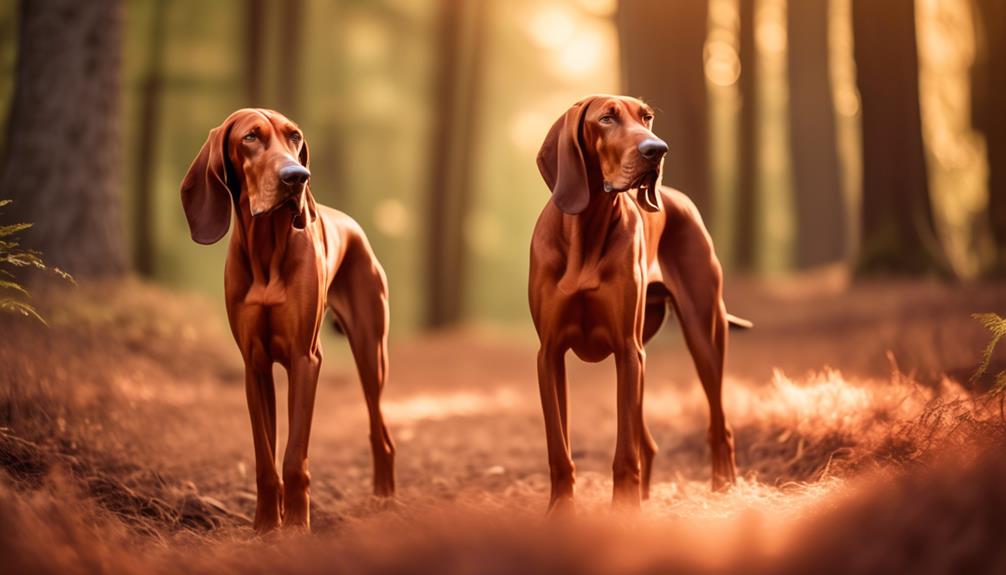
Have you ever wondered what it would be like to have a loyal companion by your side, ready to embark on thrilling adventures?
Meet the Redbone Coonhound, a breed that will chase your curiosity and keep you on your toes.
With their striking red coat and melodious baying voice, these dogs are a sight to behold.
But there’s more to them than meets the eye.
In this discussion, we will uncover the fascinating characteristics and unique qualities of the Redbone Coonhound, leaving you eager to discover why they make an exceptional addition to any family.
Key Takeaways
- Redbone Coonhounds are medium to large hunting dogs known for their friendly and outgoing nature.
- They have high energy levels and require regular exercise and mental stimulation.
- Redbone Coonhounds can adapt well to apartment living if their exercise needs are met.
- Regular grooming, proper diet, and socialization are important for their overall health and well-being.
Origin and Breed Group
The Redbone Coonhound, originating in the United States, belongs to the Hound breed group. These medium to large-sized dogs weigh between 45 and 70 pounds and have a lifespan of 12 to 15 years.
Redbone Coonhounds are known for their friendly and outgoing nature, making them exceptional hunting dogs. They’ve high energy levels and require regular exercise to stay happy and healthy. With their distinctive and melodious baying voice, they’re famous among hunters.
Redbones are intelligent and quick learners, but their strong hunting instincts can sometimes lead to stubbornness. If you’re considering getting a Redbone Coonhound, be prepared to provide them with plenty of mental and physical stimulation to keep them satisfied.
See another Dog breed profile.
Rhodesian Ridgeback Dog Breed
Size and Weight
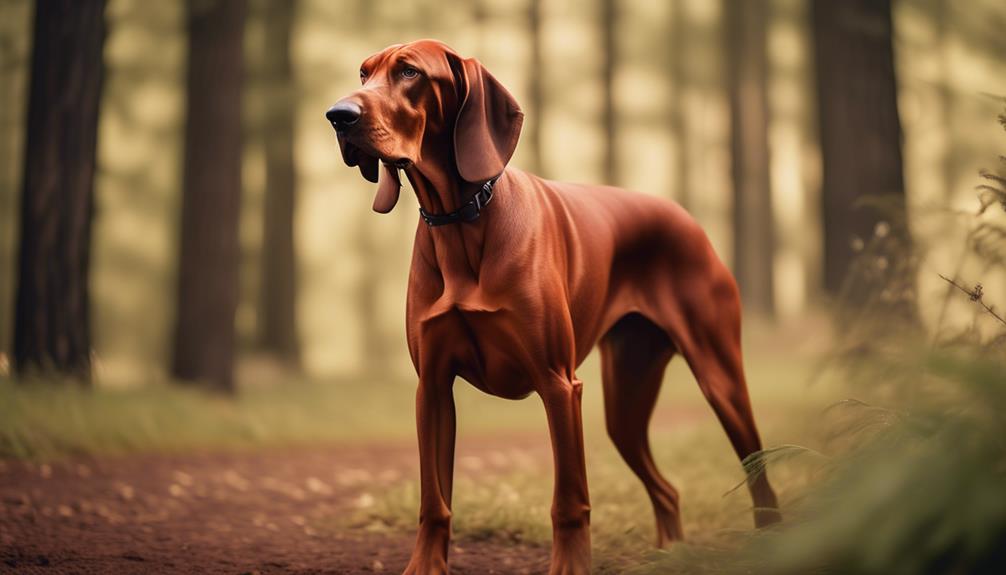
When considering the Redbone Coonhound, it’s important to take into account their size and weight. Here are some points to help you visualize their size:
- Medium to large breed, with a strong and muscular build
- Stands at around 22 to 27 inches tall at the shoulder
- Weighs between 45 to 70 pounds, depending on gender and genetics
- Their body is well-proportioned, with a deep chest and a straight back
- They have long, straight legs that enable them to move with grace and agility
These physical characteristics contribute to their endurance and ability to navigate various terrains.
The Redbone Coonhound’s size and weight make them suitable for hunting, as they can cover long distances and follow scents with ease.
Lifespan and Temperament
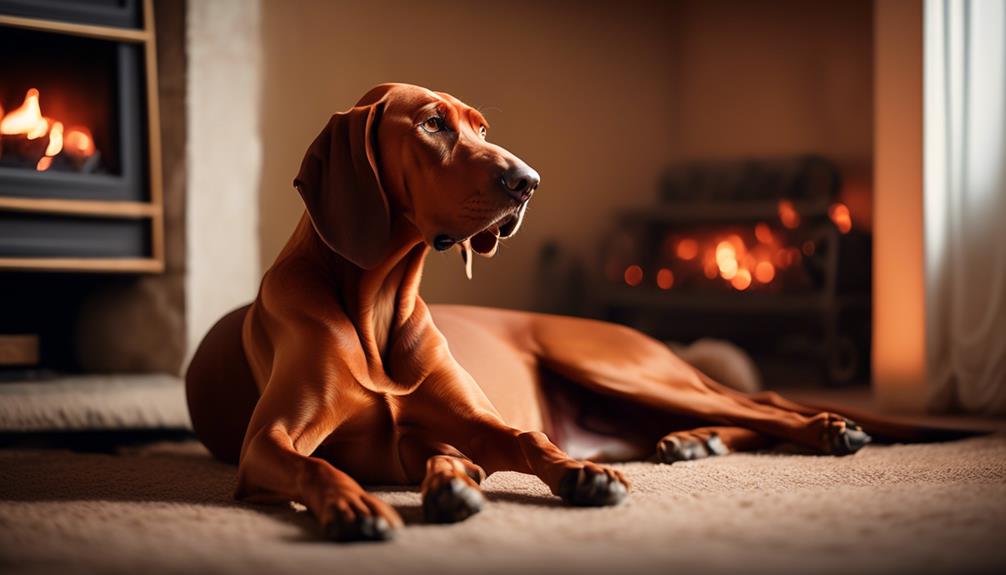
As we shift our focus to the lifespan and temperament of the Redbone Coonhound, it’s important to understand how these factors contribute to their overall character and suitability as a companion.
Redbone Coonhounds have a lifespan of 12 to 15 years, providing ample time for a deep and lasting bond with their owners.
In terms of temperament, they’re known for their friendly and outgoing nature. They’re affectionate, loyal, and make excellent family pets.
However, it’s important to note that they’ve high energy levels and require regular exercise to keep them mentally and physically stimulated.
Their hunting instincts can sometimes make them stubborn, but with proper training and socialization, they can become well-rounded and obedient companions.
Apartment Living Considerations
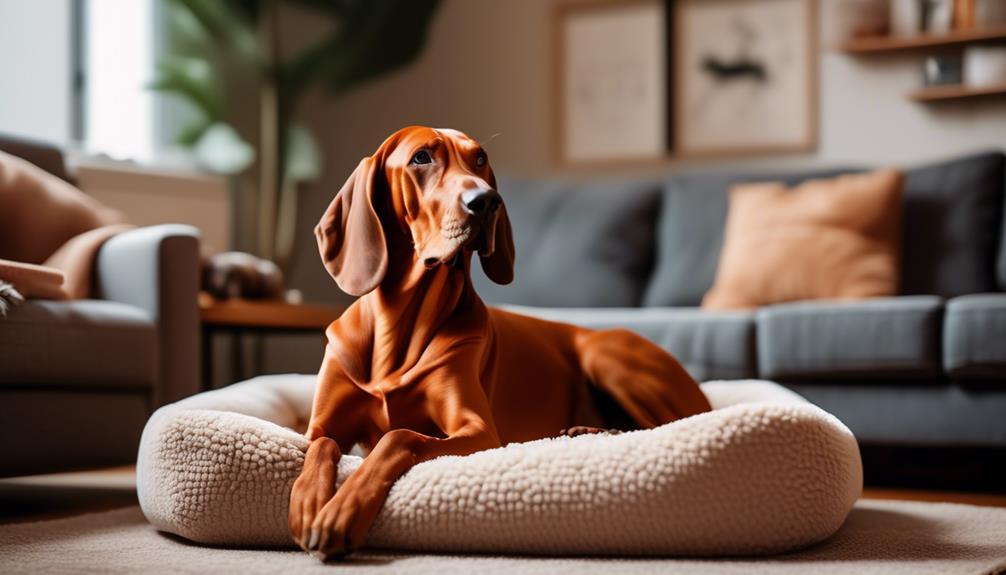
Consider the adaptability of Redbone Coonhounds to apartment living. Despite their medium to large size, Redbones can thrive in an apartment setting if certain considerations are taken into account. Here are a few key points to keep in mind:
- *Space management*: Redbones require sufficient space to move around comfortably. Ensure that your apartment provides enough room for them to stretch their legs and play.
- *Noise control*: Redbones are known for their melodious baying voice. Be mindful of your neighbors and train your Redbone to minimize excessive barking.
- *Exercise needs*: These dogs have high energy levels and need regular exercise. Plan for daily walks, trips to the dog park, or engaging play sessions to keep them physically and mentally stimulated.
- *Training and socialization*: Proper training and socialization are crucial for a harmonious living environment. Teach your Redbone basic commands and expose them to different people, animals, and environments.
- *Crate training*: Consider crate training your Redbone to provide them with a safe and cozy space within your apartment.
Exercise Needs and Activity Level
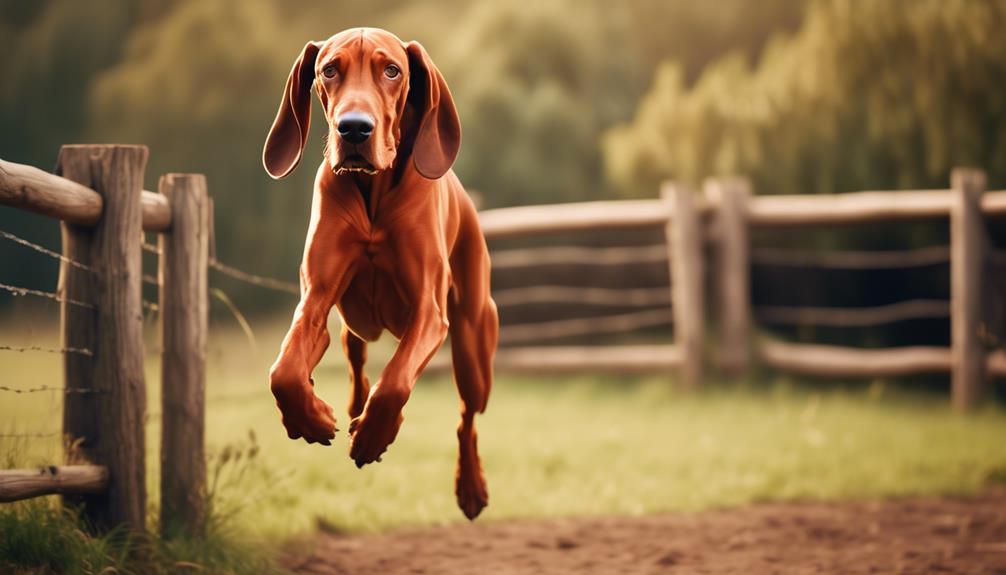
To address the exercise needs and activity level of Redbone Coonhounds, it’s important to understand their high energy levels and the amount of physical and mental stimulation they require. These dogs have a lot of energy to burn and need regular exercise to stay happy and healthy.
They’re more likely to spend their time jumping, playing, and investigating their surroundings. When choosing a breed, consider your own activity level and lifestyle. Vigorous dogs like Redbones may not be the best fit for homes with young children or elderly individuals.
Training is important for these energetic dogs to learn good manners. They thrive with daily, vigorous exercise, so make sure you can provide them with the physical activity they need.
Training and Manners
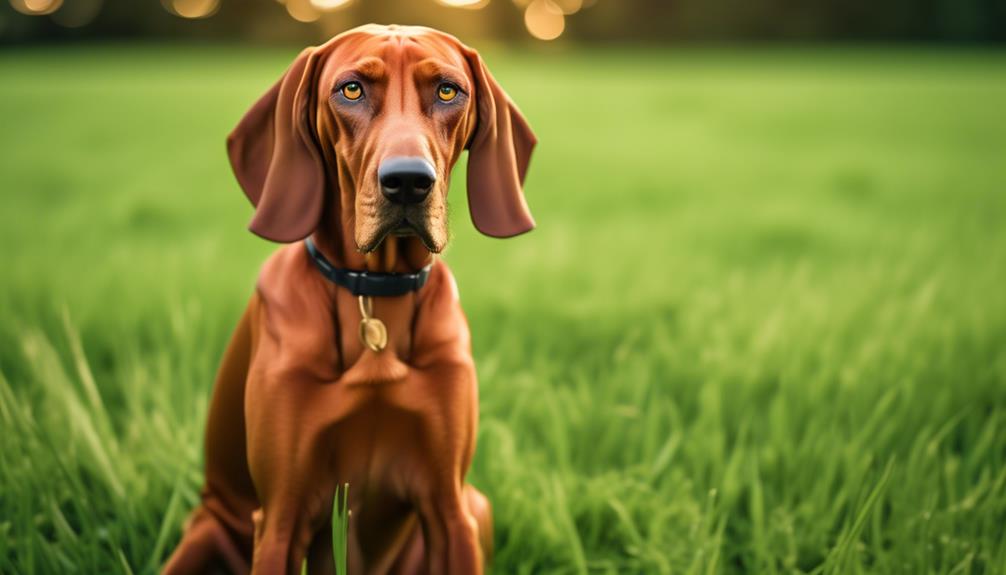
Training and manners are crucial for Redbone Coonhounds to become well-behaved and obedient companions. To help you imagine the importance of training and manners, here are some key points to consider:
- Consistent training establishes boundaries and teaches your Redbone Coonhound how to behave in various situations.
- Proper manners ensure that your dog is polite and respectful towards people and other animals.
Training helps prevent behaviors like jumping, excessive barking, and destructive chewing.
- Manners allow your Redbone Coonhound to interact positively with guests, children, and other pets.
Well-trained dogs are a joy to be around and can participate in various activities, such as obedience competitions or therapy work.
Health Issues and Care
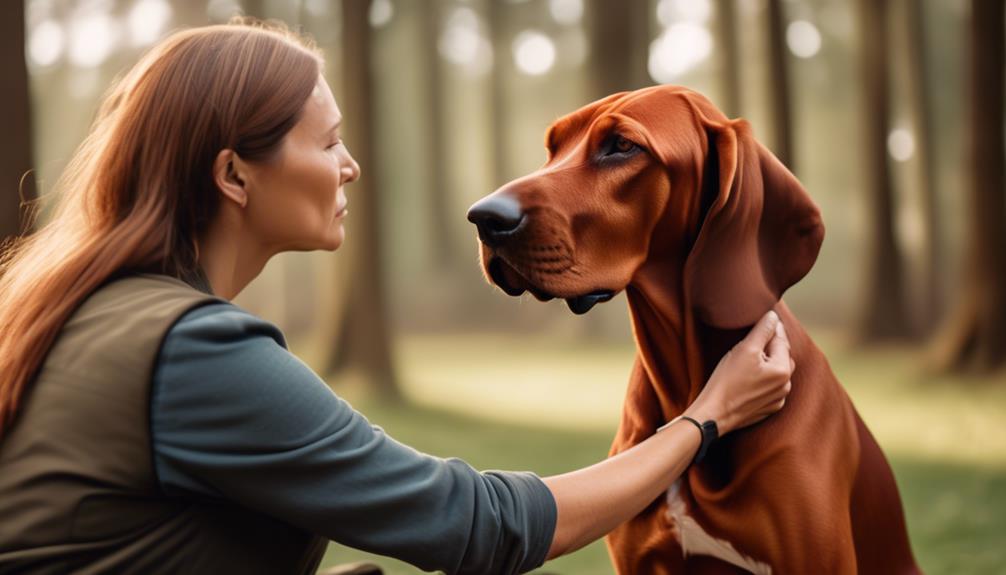
Redbone Coonhounds require regular care and attention to maintain their overall health and well-being. They are prone to certain health issues such as hip dysplasia, ear infections, obesity, bloat, and heart issues. To ensure their health, it is important to provide regular cleaning and inspection of their ears, monitor their diet, and provide regular exercise to prevent weight gain. Immediate veterinary attention is required for bloat, and regular check-ups are important to monitor for heart conditions. Redbone Coonhounds have high energy levels and require daily walks or vigorous play sessions. Regular brushing is needed to maintain their short and smooth coat. They thrive on social interaction and should not be left alone for long periods. Balanced diet, high-quality food, portion control, and access to fresh water are important for their feeding.
| Health Issues | Care Tips |
|---|---|
| Hip dysplasia | Regular exercise and joint supplements |
| Ear infections | Regular cleaning and inspection of the ears |
| Obesity | Monitor diet and provide regular exercise |
| Bloat | Immediate veterinary attention |
| Heart issues | Regular check-ups and monitoring for any symptoms |
Ear Cleaning and Inspection
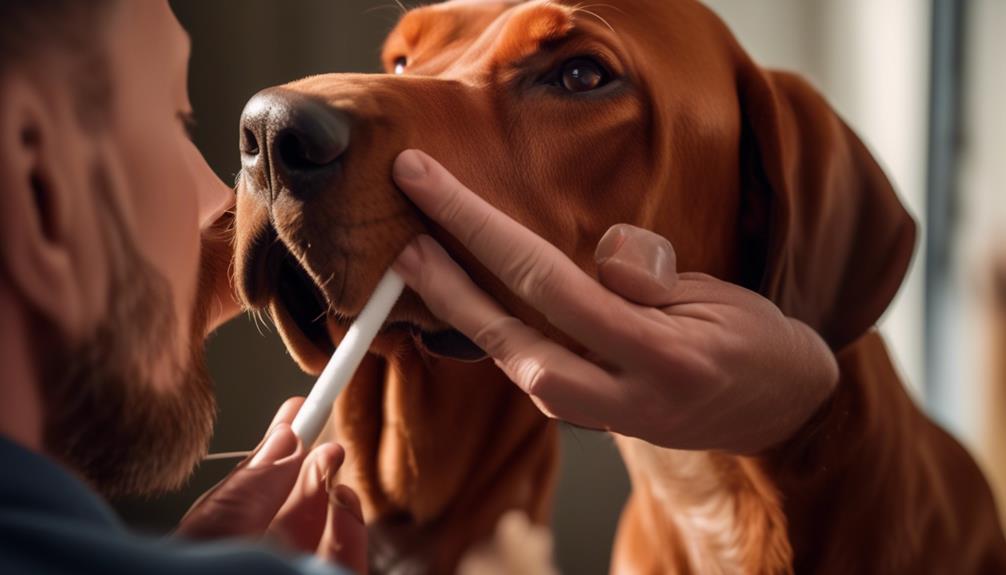
Regular care and attention are necessary to ensure the overall health and well-being of Redbone Coonhounds, including proper maintenance of their ears through regular cleaning and inspection. To keep your Redbone Coonhound’s ears in top shape, here are some important steps to follow:
- Gently wipe the outer part of the ear with a damp cloth to remove dirt and debris.
- Use a veterinarian-recommended ear cleanser to clean the inner part of the ear, being careful not to insert anything into the ear canal.
- Inspect the ears for any signs of redness, swelling, discharge, or odor.
- Check for ear mites or ticks, especially if your dog has been exposed to wooded areas.
- If you notice any abnormalities or if your dog shows signs of discomfort, consult your veterinarian for further guidance.
Weight Management and Preventing Obesity
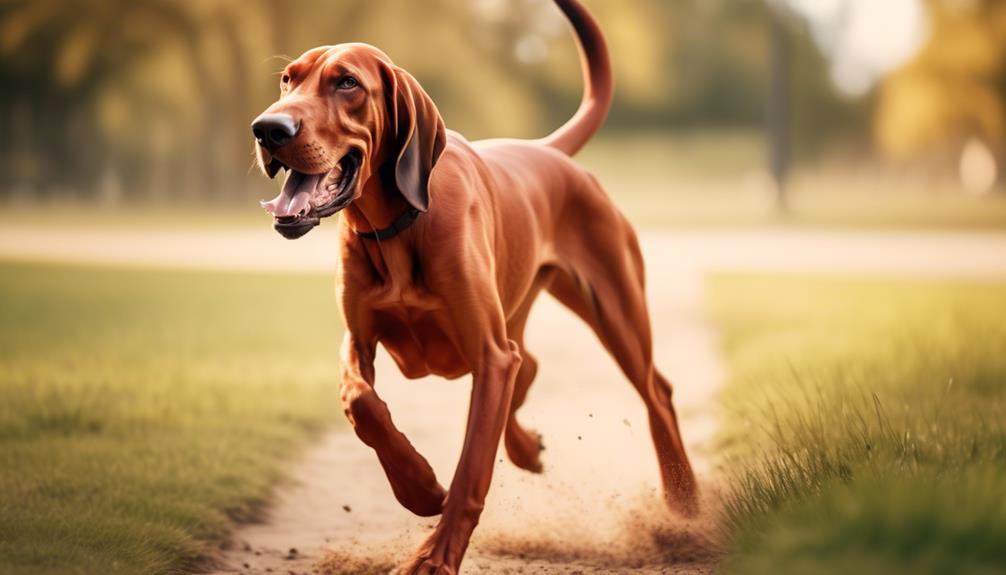
To effectively manage your Redbone Coonhound’s weight and prevent obesity, it’s important to establish a balanced and nutritious diet. Providing your dog with high-quality food that meets their nutritional needs is essential. Avoid overfeeding and monitor portion sizes to prevent excessive weight gain.
Incorporate regular exercise into your Redbone Coonhound’s routine to help them burn calories and stay fit. Daily walks, play sessions, and mentally stimulating activities are recommended to keep them active and avoid sedentary behavior.
Regular veterinary check-ups can help monitor your dog’s weight and overall health. If you notice any signs of weight gain or obesity, consult with your veterinarian for personalized dietary recommendations and weight management strategies.
Bloat and Immediate Veterinary Attention
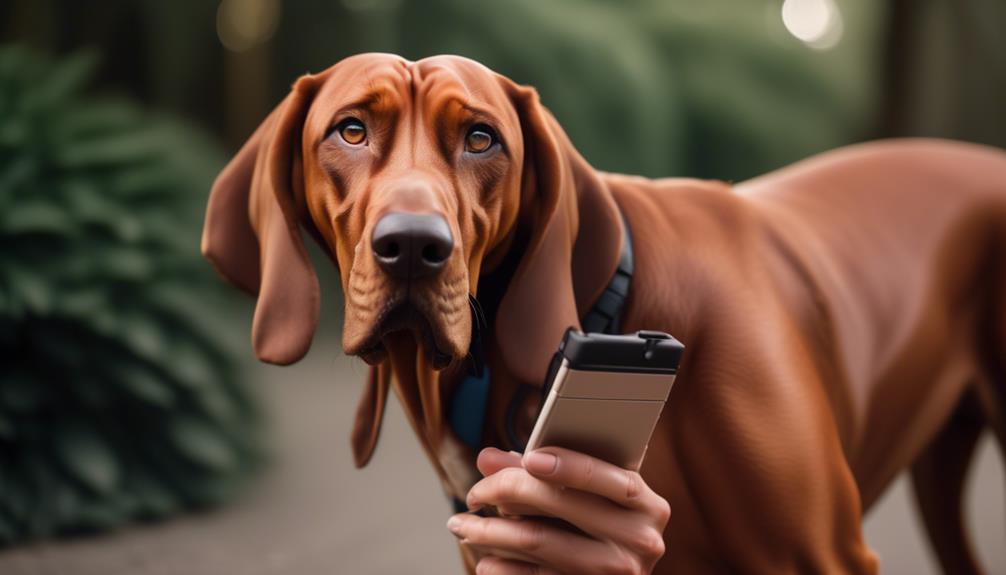
If you notice any signs of bloat in your Redbone Coonhound, immediate veterinary attention is crucial. Bloat is a life-threatening condition that requires prompt intervention.
Here are some alarming signs to watch out for:
- Distended or swollen abdomen: Imagine your dog’s belly suddenly expanding, becoming tight and bloated.
- Unproductive attempts to vomit: Picture your Redbone Coonhound retching or gagging without anything coming up.
- Restlessness and discomfort: Visualize your dog pacing, unable to find a comfortable position.
- Rapid breathing and increased heart rate: Imagine your dog panting heavily with a rapid pulse.
- Pale gums and weakness: Picture your dog’s gums turning pale and your normally energetic companion becoming weak and lethargic.
Heart Conditions and Regular Check-ups
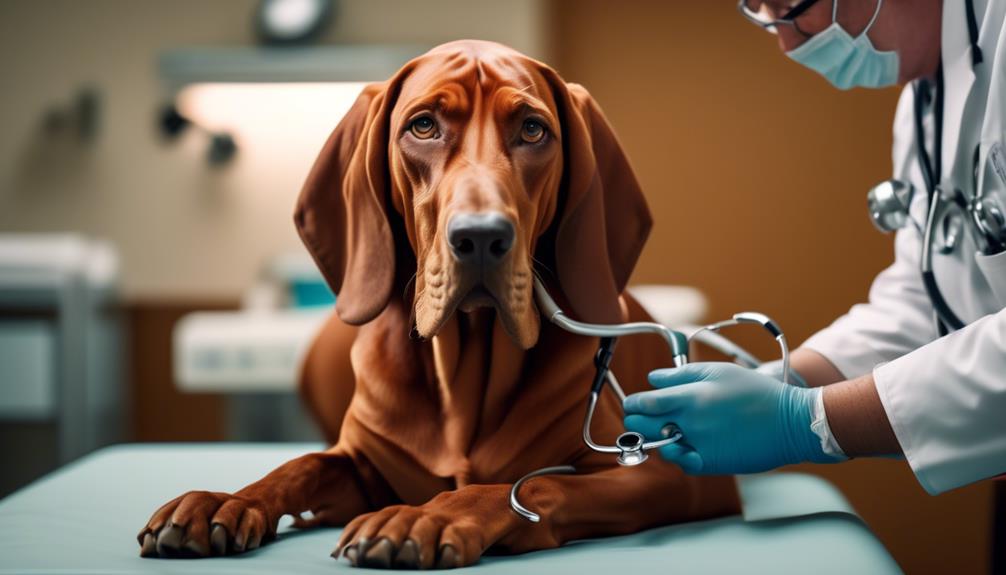
Monitoring your Redbone Coonhound for heart conditions and scheduling regular check-ups is essential for their overall health and well-being. Redbone Coonhounds are prone to heart issues, so it’s important to stay vigilant.
Regular check-ups with a veterinarian will help detect any potential problems early on. During these check-ups, your veterinarian will listen to your dog’s heart, check their pulse, and may recommend further tests such as an electrocardiogram or an echocardiogram. These tests can provide valuable information about your Redbone Coonhound’s heart health.
Additionally, your veterinarian may recommend lifestyle changes or prescribe medication to manage any heart conditions that may be present.
Coat Maintenance and Grooming
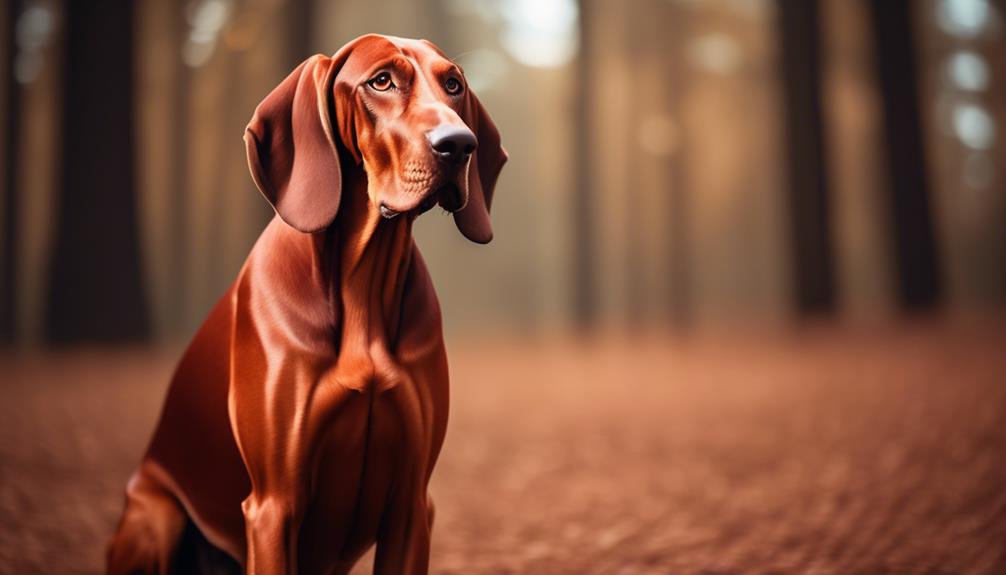
Regular grooming is essential for maintaining the short and smooth coat of your Redbone Coonhound, ensuring that they look their best and stay comfortable. To keep your Redbone’s coat in top condition, here are some important tips:
- Brush their coat regularly to remove any loose hair and keep it shiny.
- Use a soft-bristle brush or a rubber curry brush to gently massage their skin and stimulate blood circulation.
- Check their ears regularly for any signs of infection or excess wax buildup.
- Trim their nails regularly to prevent them from becoming too long and causing discomfort.
- Bathe your Redbone Coonhound as needed, using a mild dog shampoo and warm water to keep their coat clean and odor-free.
Socialization and Interaction Needs
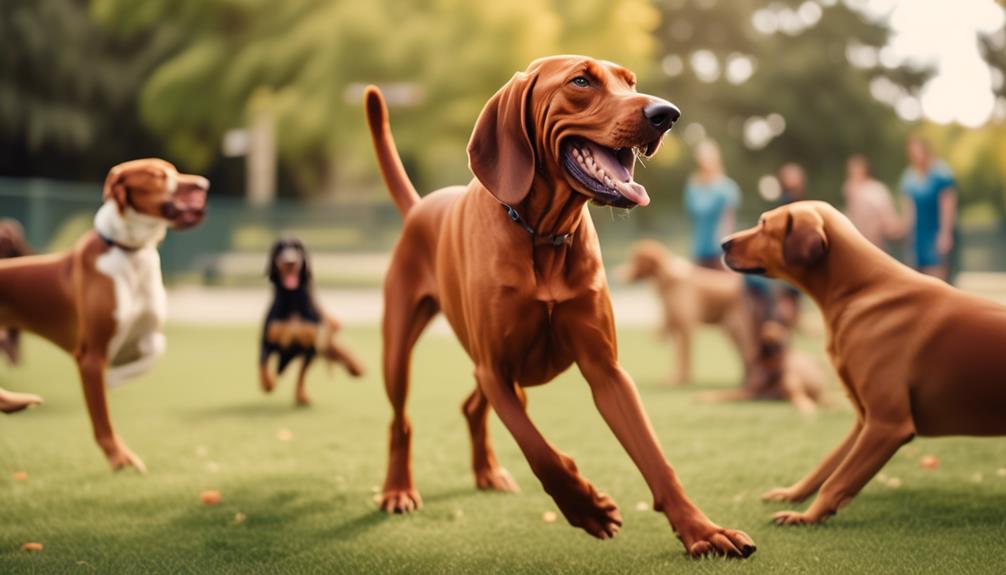
To ensure a well-rounded and happy Redbone Coonhound, it’s crucial to prioritize socialization and regular interaction with other dogs and animals. Redbones thrive on social interaction and shouldn’t be left alone for long periods.
By exposing them to different environments, people, and animals from a young age, you can help them develop good social skills and prevent behavioral issues. Take them to dog parks, enroll them in obedience classes, and arrange playdates with other friendly dogs. This will help them learn how to properly interact and communicate with their canine counterparts.
Additionally, providing opportunities for them to interact with other animals, such as cats or small mammals, can help them learn to coexist peacefully. Remember, a well-socialized Redbone Coonhound is a happy and well-adjusted companion.
Feeding and Dietary Considerations
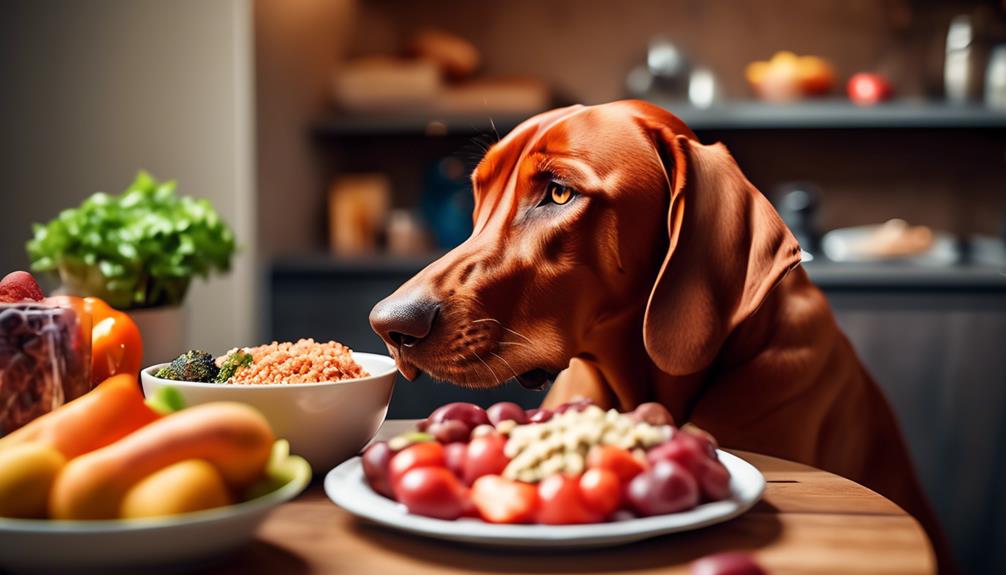
To ensure that your Redbone Coonhound receives proper care and nutrition, let’s now discuss the subtopic of Feeding and Dietary Considerations.
- Choose a high-quality dog food that meets the nutritional needs of your Redbone Coonhound.
- Consider the age, size, and activity level of your dog when determining the appropriate portion size.
- Provide a balanced diet that includes a mix of protein, carbohydrates, and fats.
- Offer fresh water at all times to keep your dog hydrated.
- Consult with your veterinarian for personalized dietary recommendations and any special considerations for your Redbone Coonhound’s health.
Children, Other Pets, and Prey Drive
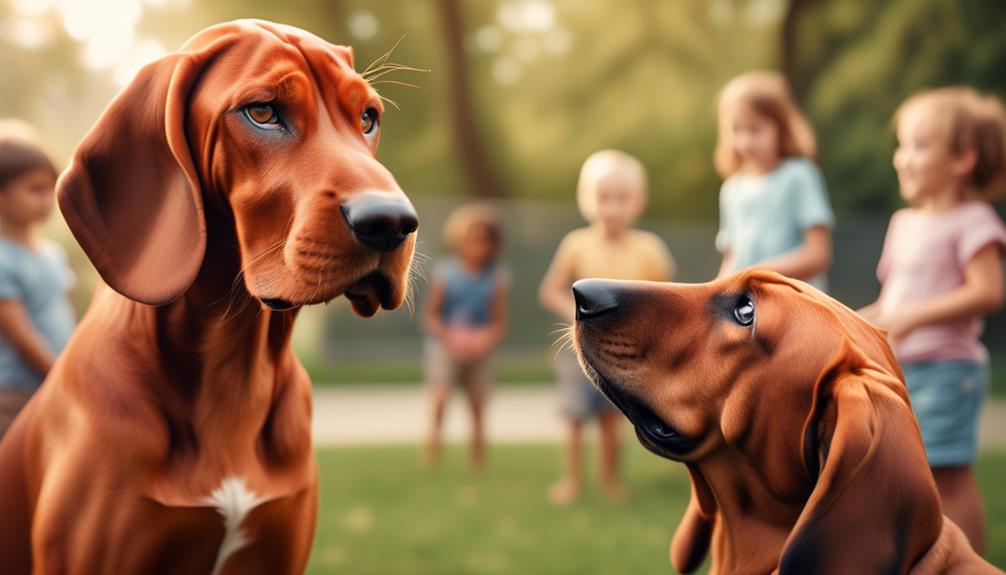
When it comes to Redbone Coonhounds, it’s important to consider their behavior around children, other pets, and their prey drive. Redbones are known for being patient and gentle with children of all ages, but supervision is necessary to prevent rough play. With proper socialization, they can coexist harmoniously with other pets. However, their strong hunting background may trigger a prey drive, leading them to chase smaller animals. Training is crucial to ensure peaceful cohabitation with other pets. To engage the audience, here is a table summarizing the behavior of Redbone Coonhounds around children, other pets, and their prey drive:
| Behavior | Description |
|---|---|
| Children | Patient and gentle, but supervision is needed |
| Other Pets | Can coexist harmoniously with proper socialization |
| Prey Drive | May chase smaller animals, training is essential |
Frequently Asked Questions
Are Redbone Coonhounds Good With Children and Other Pets?
Yes, they are good with children and other pets. Redbone Coonhounds are patient and gentle with children of all ages. They can coexist harmoniously with other pets through proper socialization and training.
How Often Should Redbone Coonhounds Have Their Ears Cleaned and Inspected?
You should clean and inspect your Redbone Coonhound’s ears regularly to prevent infections. This should be done as often as necessary, but at least once a week is recommended.
What Measures Can Be Taken to Prevent Obesity in Redbone Coonhounds?
To prevent obesity in your Redbone Coonhound, you can take measures such as monitoring their diet, providing regular exercise, and practicing portion control. These steps will help maintain a healthy weight and prevent weight gain.
When Should Immediate Veterinary Attention Be Sought for a Redbone Coonhound With Bloat?
If your Redbone Coonhound shows signs of bloat, such as a distended abdomen, restlessness, or unproductive retching, seek immediate veterinary attention. Bloat is a serious condition that requires prompt medical intervention.
How Often Should Redbone Coonhounds Have Regular Check-Ups for Monitoring Heart Conditions?
For monitoring heart conditions, regular check-ups are essential. Make sure to schedule them as recommended by your veterinarian. It’s important to stay proactive in monitoring your dog’s health and catching any potential issues early on.
Conclusion
In conclusion, the Redbone Coonhound is a friendly and outgoing hunting dog that can adapt well to apartment living with proper exercise and mental stimulation.
Their high energy levels and distinctive baying voice make them excellent hunting companions.
With regular grooming and care, this medium to large-sized breed can thrive and maintain their overall well-being.
Whether you’re a seasoned dog owner or a first-time pet parent, the Redbone Coonhound could be the perfect addition to your family.




